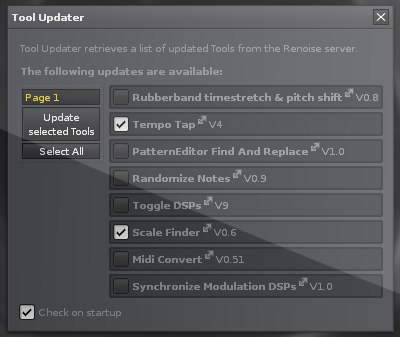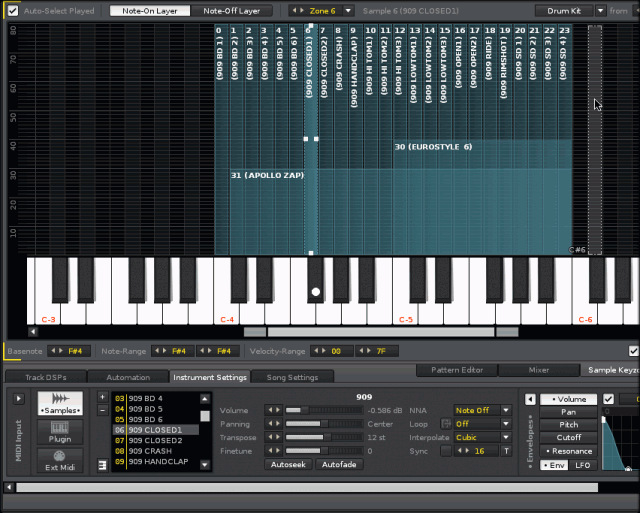Renoise 2.7 is now available, following some eight weeks of testing by the community. The update, which the developers describe as “back to the beats” in reference to focusing in this release cycle on musical workflow, delivers plenty of features that make the modern tracker more modern. I wrote about them back in March, with some detailed Q&A from the developers – including tips on where to get started:
Renoise 2.7 Adds Sample and Slice Savvy; Tips and Inside Info from the Developers
The short version: better automation, sample slicing, and sample keyzones, plus improved DSP and audio routing and MIDI routing, make Renoise more usable. For people slicing up and sampling audio, even, I dare say, MPC-style, it’s a huge release.
But that’s not the only story here. Renoise are also announcing 500 MB of free sounds designed by Puremagnetik, all in the native XRNI file format. That’s from a sound house better known for Ableton Live sounds than Renoise. And, at the opposite end of the spectrum from preset soundware, Renoise is involved in a Berlin Music Hackday that could bring new DIY features to the tool – plus tooling that makes it easier to grab and update tools from the community.
We’ll start with the Puremagnetik news. Rather than just tell you about the sounds, Puremagnetik’s Micah Frank shares how the sound set was built, and what they learned about making soundware for Renoise. That includes some valuable tips for anyone interested in programming sounds in the environment, as well as insight if you’re just curious to try the resulting sound pack free. Micah shares:
About Puremagnetik: Puremagnetik is a sound development company that I founded in 2006. I had freelanced as a sound designer with Ableton for some years and didn’t see many 3rd party choices for that platform. Puremagnetik was launched as an affordable subscription service offering new “Micropaks” every month, with a focus on Ableton Live content. That was 5 years ago and we are continuing to produce new packs every month. As of this writing we have almost 60 Micropaks in the catalog, a number of bundles, standalone libraries and Max for Live content. We have close to 40k registered users and are working with a number of developers (desktop and mobile) to help realize their sound libraries. By the time you read this, we will also be offering content in Renoise’s XRNI format.
Why Renoise: Always on the lookout for products that break away from conventions, I became interested in content development for Renoise soon after the 2.6 release. It’s obvious that Renoise is created by a small and dedicated team of developers backed by a strong, supportive community. To my surprise, I couldn’t find many resources for Renoise format instruments. All of the above reasons factored into Puremagnetik’s conception in the first place – to fill a niche within a community of dedicated individuals that are passionate about their work. Once the Keyzone Editor was introduced, it was clear to me that someone had to make content for this innovative product.
What it was like making the 500M sample pack: The first thing we did is comb through our entire catalog and pick a well-rounded selection of kits and multisample instruments. We are working with an independent developer (Renoise user MXB in building a tool to translate our libraries to XRNI. [That tool is now released; see comments. -Ed.] So this was a huge asset in efficiently building this library. After importing the sounds they were fine tuned and tweaked with modulations and envelopes. The final step was exporting the monolithic XRNI files. Throughout the entire process we worked alongside the Renoise team to ensure that Q/A standards and selection of sounds was spot-on.
Thoughts on the latest XRNI format: Despite its simple interface there is a lot going on under the hood. I personally love the “point” setting in the envelope params. And the selection of filters really kicks ass (my favorite is the Low Distortion). Just in coupling these two things, one is presented with vast sound design possibilities, and that’s before you beat sync pitch envelopes!
For the most part, editing is very intuitive if you have previously built multisample instruments. The instrument editor is still in its infancy so there are some parameter persistency issues that need to be ironed out. It is somewhat cumbersome to save variations of the same instrument as it saves each one as a single monolithic (flac compressed) file.
Overall, it’s easy enough to dive into the editor, tweak the available settings and resave the instrument however you like.
Room for improvement in the format: The most valuable thing for us from a development standpoint is sample grouping capabilities. Our instruments really become 3 dimensional once we can program group modulations based on user events. Our TeeBee instrument for example is heavily dependent on groups of samples to create a realistic emulation of the original TB303. So this is a feature I would like to see implemented.
I would love to be able to save track DSPs with the instrument but perhaps that could conflict with Renoise’s native architecture and workflow. However, this capability when combined with Renoise’s effects and Meta Devices could open enormous possibilities for sound design.
More LFO waveforms with an even slower frequency would be very welcomed into my Renoise sound design toolbox!
Each parameter setting has 4 envelope preset slots but these are currently shared between parameters and are only session specific. It would be really cool to have independent preset buttons per parameter that save with the instrument. That way, the user can load it up and call any number of combinations for instant sound shaping variations.
Velocity crossfading.
Visit Puremagnetik at http://puremagnetik.com/ — you’ll see new Renoise-format sounds starting to appear.
Included in this pack:
Analog Synth Basses
Circuit Bent Drum Kits
Buchla Drum Kits
Mellotron Strings and Flutes
Glitch, Toy & Lo-Fi Sounds
Fender Rhodes Mark II
Model-C Clavinet
Electric Guitar
Upright Bass
Classic Analog Synths
Grand Piano
And there’s more soundware free with this release, too, I see from the Renoise site:
Additionally, Berlin based artist and longtime user Beatslaughter has blessed us with a touch of evil in his sample pack “Beatslaughter SoundPack Volume 1”.
Those two sample packs total over 800 MB and let producers jump into all the latest sampling features of Renoise 2.7. The packs are free for all registered users new and old, and are waiting in the Backstage.
Get Your Tools Faster

It’s like an App Store for Renoise hacks: tools.renoise.com has gotten an upgrade, and there’s a new automatic updater called the Tool Updater. Combined, this should make it easier to keep your tools fresh, and customize Renoise to do what you need. I’m a huge fan of the lightweight hacking mechanism they’ve built into Renoise, and the fact that it’s an integral part of the software.
Hack Renoise
As a mentor at Music Hackday Berlin, if you happen to be in Germany later this month, you can learn how to hack Renoise from the developers. I’d love to see some new projects. (I may even try to see if I can drop by, if I’m in fact in England around the same time!)
Renoise will be mentoring at Music Hack Day Berlin. The event takes place on the weekend of May 28th in the MTV Network offices located at the Spree river. Erik, dblue and Taktik will be on site to discuss Renoise, the Lua API, drink beer, and give out high fives. Check our community forums in the upcoming days for more details.
Background/info:
http://musichackday.org/
http://vimeo.com/7129735
http://www.wired.com/epicenter/2011/02/music-hack-day-nyc/
http://fuse.tv/music/music-hack-day/
http://www.billboard.biz/bbbiz/industry/digital-and-mobile/midem-2011-can-hacking-save-music-1005009032.story
http://blog.programmableweb.com/2010/02/03/48-hours-31-hacks-stockholm-music-hack-day/
And yes, I’ll happily, happily share any interesting hacks or creations here on CDM.
Of course, there’s plenty here to enjoy in Renoise even if you don’t hack – you can grab some free sounds and go play! Let us know what you think.
